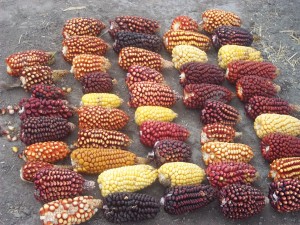
EL BATAN, Mexico (CIMMYT) — Doubled haploid (DH) technology provides important benefits to maize breeding programs by enhancing genetic gains, improving breeding efficiency and offering significant economic advantages.
Unfortunately, this technology is limited by the fact that the R1-nj (Navajo) anthocyanin color marker cannot effectively identify haploids in many crosses where inhibitor genes prevent color expression in the seed. A new study from the MAIZE CGIAR Research Program titled “Development and validation of red root marker-based haploid inducers that effectively complement R1-nj (Navajo) marker-based in vivo haploid identification in maize” states that the Navajo marker caused a high percentage of false positives, especially in varieties with natural purple coloring, due to high anthocyanin content.
To combat this issue, the study recommends the use of triple anthocyanin color markers, in which the red/purple coloration is expressed in seedling roots and leaf sheaths in addition to the Navajo marker on the seed. Researchers found that use of the red root marker improved the accurate identification of haploids, especially in seeds that already have a natural purple color due to high anthocyanin content.
Read more about this research and other recent studies from CIMMYT scientists below.
- Development and validation of red root marker-based haploid inducers that effectively complement R1-nj (Navajo) marker-based in vivo haploid identification in maize. 2016. Chaikam, V.; Martinez, L.; Melchinger, A.E.; Schipprack, W.; Prasanna, B.M. Crop Science. Online First.
- Determinants of agricultural technology adoption under partial population awareness : the case of pigeonpea in Malawi. 2016. Simtowe, F.; Asfaw, S.; Tsedeke Abate. Agricultural and food economics 4 : 7.
- Evaluating manual conservation agriculture systems in southern Africa. 2016. Thierfelder, C.; Matemba-Mutasa, R.; Bunderson, W.T.; Mutenje, M.; Nyagumbo, I.; Mupangwa, W. Agriculture, Ecosystems and Environment 222 : 112-124.
- Identification of spring wheat genotypes by glutenin and gliadin subunit composition within the Kazakhstan Siberia network of nurseries. 2016. Abugalieva, A.I.; Morgounov, A.I.; Pena, R.H.; Volkovinskaya, N.B.; Savin, T.V. Russian Journal of Genetics : Applied Research 6 (1) : 44-53.
- Molecular mapping of a new temperature-sensitive gene LrZH22 for leaf rust resistance in Chinese wheat cultivar Zhoumai 22. 2016. Cuifen Wang; Guihong Yin; Xia Xian-Chun; He Zhonghu; Zhang, P; Zhanjun Yao; Jinyan Qin; Zaifeng Li; Daqun Liu. Molecular Breeding 36 : 18.
- Transitioning to groundwater irrigated intensified agriculture in Sub-Saharan Africa : an indicator based assessment. 2016. Amjath-Babu, T.S.; Krupnik, T.J.; Kaechele, H.; Aravindakshan, S.; Sietz, D. Agricultural Water Management 168 : 125-135.
 Innovations
Innovations 
